|
Do you have a dog who struggles to get through their conditioning session? Do you have a dog that is unsure about some of the equipment in canine conditioning (e.g. wobble boards)? Do you find your dog lacks motivation? Does your dog easily “shut-down” when they make mistakes? You are not alone! In my last blog, we took a look at high drive dogs and discussed strategies to get them more focused during their canine conditioning sessions. But what if you own a dog who is the exact opposite and you're trying to find ways to bring them up and improve their confidence? The truth is, not every dog will approach conditioning with a “go get em” attitude and managing low energy can be a huge and discouraging challenge for many owners. Many dogs struggle with a lack of confidence and it’s important that we, as their training partners, protect our dog’s confidence when we’re training. This means, paying attention to both the subtle and not so subtle cues our dogs are giving us and making adjustments in our sessions as needed (e.g changing equipment to something easier, shortening the training session). I often see handlers rushing their dogs onto equipment by either physically placing them on it or using equipment that their dog isn't quite ready for. I want you to take a moment and think about a situation where maybe you weren’t so comfortable?? A couple years ago, I started a weight lifting program and when I first started, I was not comfortable!! It was so new to me and I was unsure about my mechanics or how to approach my work out! I was so thankful for GREAT coaches who guided and helped me overcome my fears and slowly built up my confidence which led to a more enjoyable and stress-free work out sessions. The same will ring true for the approach you take with your dog who might be showing lower confidence and enthusiasm in the canine conditioning gym. In this week’s blog, I take a look at how to help build your dog's enthusiasm and confidence for canine conditioning and how some simple changes and games can make a world of difference! Why Does My Dog Lack Confidence? Low confidence in dogs is multi-factorial; meaning, there can be MANY reasons for it including:
Regardless of the ‘why’ behind our dog’s low confidence, we have to recognize this aspect in our dog and make sure we do everything that we can to build up their confidence. Chances are, if your dog shows low confidence in the conditioning gym they're likely to show it in other areas of their life as well. As trainers, we'll have to adapt what we do in a given situation to help our dog find their confidence. What Does Low Confidence Look Like? There are a number of signs that we can keep an eye out for that indicates when our dogs are feeling a lack of confidence. Our dogs may show only one or several of the following indicators: What Are the Challenges of Low Confidence in Canine Conditioning? If your dog lacks enthusiasm you may find getting a full workout completed in conditioning difficult. Low confidence dogs often show low enthusiasm for work and may shut down easily if we ask them to repeat a behaviour. In conditioning, we often have to reset our dog to find our desired position which can lead our dog to worry and begin to shut down. As a trainer, it can become tiring to be a constant “cheerleader” for our dog. Here are some other challenges you may experience with a low confident dog:
Doers vs. ThinkersMindset plays an important role not just in the way you train but also in how your dog approaches training. In past blogs, I’ve discussed the importance of mindset for the trainer but did you know our dogs also have their own mindsets that can affect a training session? We can generally split our dogs into two different types of thinking – some dogs are “doers” and show a gung-ho nature, willing to jump into any task. These dogs tend to be quite active, always on the go, and are very enthusiastic. I’ve been fairly lucky and all my dogs tend to be “doers” which is great for sport training and for their conditioning activities. However, another type of dog is the “over thinker” or “worrier” dog. As the name implies this type of dog is more pessimistic and thinks too much on a task making it more difficult. Our dog’s mindset can drastically alter how they approach new challenges, training environments, and corrections. For example, a “doer” dog is ready for whatever you throw at them and are not worried about making mistakes. New environments, new challenges, or new exercises are something that is inherently fun and exciting. For the low confidence or “thinker” dog this is more likely to be met with pessimism. Your dog may be unsure of the “game” they’re playing, may worry about making mistakes, or overthink the behaviors you are asking of them. Generally speaking, a pessimistic dog is also likely to have lower arousal level as well which will then feed into their low confidence. Additionally, if our dogs are “thinkers” or “worriers” they’ll often have a harder time dealing with correction. In conditioning, if you have to continually reset your dog’s position or ask them to repeat a behavior they may begin to worry and shut down. When “doer” dogs make a mistake they’re often quite willing to just try again but a “worrier” will begin to over think and may give up if asked to continually adjust. Strategies for Managing Low Confidence Now that we understand what low confidence looks like, its challenges, and how a dog’s mindset plays a role we can begin to figure out ways to help build up their enthusiasm. The good news is there are a number of things we can do! One of my favourite ways to help improve my dog’s confidence is to follow Susan Garrett’s 5 C Formula for Success. By considering each of these 5 steps you are increasing your odds of a successful training session that will build up your dog’s confidence and reduce the chances of your dog shutting down.
In canine conditioning, there are a number of ways to help our low confident dogs find success in the canine gym. The following strategies can be applied to help grow and nourish your dog's confidence and enthusiasm.
If they are unsure and quite hesitant to engage with the equipment, start further back and create more space between you and the piece of equipment. Make sure you reward for any engagement – some dogs might just look at the equipment at first – reward that!! Use high value treats as well!! Once your dog is at the point of touching the equipment you can reward for your dog touching and placing their feet on it and then toss another cookie away to “reset” them. Repeat this process. Never ask your dog for any static behaviours on new equipment until you see that they are comfortable working around and on it. – e.g. targeting with front feet, hind feet, walking across it. As you go through this process, be sure to monitor for signs of decreased confidence or uncertainty. Once you know your dog is comfortable on the piece of equipment you introduced them to, you can start to ask for various behaviours and positions on it. Strategies to Help the Low Confident Dog – Games!! 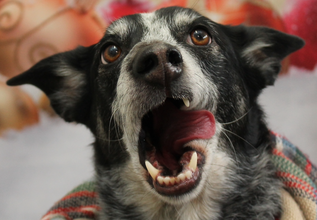 Who doesn't love diving for treats!? (Photo submitted by K Grant) Who doesn't love diving for treats!? (Photo submitted by K Grant) I am a firm believer in using game-based training with my dogs as it builds confidence, communication, and trust between myself and my dog. I use these games every day with my dogs before we do any exercise or training. Before you start any game, check in with your dog – are they happy, ears up, eyes bright and engaged and eager to play the game with you? Remember, these are games and it doesn’t really matter if they do it perfectly or not just to get them in the mood to PLAY!! Here are three of my favourite games to build confidence in dogs. Treat Diving This fun and easy game from Susan Garrett’s Home School Program builds up your relationship with your dog and improves their confidence. In Treat Diving, our goal is to have our dogs enthusiastically “dive” for treats. When getting ready to play this game, prep 5 food containers that will hold 5 various types of treats. This is a great opportunity to see what your dog really gets amped up for!! You should play this game in an environment that is anti-slip - it is pretty hard to build confidence if your dog is worried about slipping around!! Pull out those yoga mats!! For lower confident dogs, you should start by playing this game for 30-45 seconds and then break off into a play session!! Be sure to set a timer as it is VERY easy to fall trap to a longer session. Short sessions for the win and slowly work up to 2 minutes. There are three stages to this game: Stage 1 – Take 3 cookies of EACH treat!! Start with reward/food # 1 – toss food (don’t say anything). Dog should retrieve food. Handler can stay stationary at first and then add a bit of motion. Watch your dog's response – did they dive onto the food to get it? Were they enthusiastic to dive to the next treat?? Then toss again. Repeat for 3 reps with the same type of treat. Then, place your dog back in a crate or on a bed why you prep reward/food #2. Repeat the same process with the next food! Work your way through all five treats!! You may NOT get through all 5 treats in the same session - that is ok! Once your dog is consistently diving onto the treats and showing enthusiasm for the game, it is time to move onto Stage 2. Stage 2 – The steps during this stage are the SAME as Stage 1 except we are now adding a verbal command to the game. Use any verbal command (e.g. search) and be sure it doesn't have any other meaning to your dog. Say the word ‘search’ and then toss the cookie! Remember to make sure you say your verbal command first, and then toss the cookie. In this stage you verbal command is giving your dog permission to look for food on the ground. Repeat this process with all five of your treats. Stage 3 – During this stage you can start to introduce a bed/mat. Grab a mixture of treats (from the original 5!). Use your verbal command you used in Stage 2 (e.g. search) and toss food directly on the bed/mat you are using. Repeat this several times. Then drop a treat off and outside of the bed/mat. Notice how after your dog retrieves the cookie (off the bed) they start to gravitate back to it!! Your dog will start to build value for the bed/mat in realizing that this is where lots of treats go to!! That’s it!! Practice this multiple times a day!! YOUR DOGS WILL LOVE THIS GAME!!!!! Cone Game This game is a fantastic way to build confidence, optimism, and is fun! To play this game, all you need is plastic cone or cup that your dog can fit their muzzle in. Start with your dog on a cot or mat so you can get your cone and cookies organized! Release your dog and reward any kind of interaction with the cone and then progressively become more specific about placing their nose IN the cone. Check out the video below to see how the game is played! 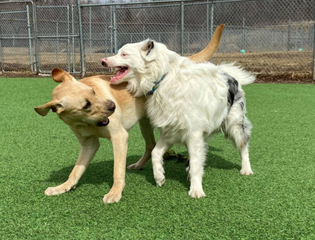 (Photo submitted by K Grant) (Photo submitted by K Grant) Natural Play Another way to build confidence is to learn how your dog likes to play on their own! Not all dogs will play the same and a good way to help build up confidence is to figure out what gets your dog excited and what their “rules” of the game are! Observe your dog in their natural setting and note how they interact with dogs and other stimuli. Does your dog like to chase after things, do they like to stalk, do they like physical play? Once you figure out “how” they like to play you can then figure out what not to do! For example, a dog that likes to chase may not like to be touched. If you were to play a game of chase with a tug toy your dog would likely become quite excited. If, while tugging, you were to tap or push your dog they may end up spitting out the tug toy and disengaging – this is because you just broke the rules! Once you understand the rules of your dog’s game you can then set up you play session to be highly rewarding and fun. Play that follows your dog’s rules helps to get your dog into a positive mindset making them more trusting with you and more willing to try new things. In conclusion...Just because your dog is lower on the confidence scale does not mean they have to stay there. Building up confidence in tasks and behaviours is the best way to allow the dog to build more drive for the work. The approach might be different but the end result can be the same as the high drive dogs. Canine conditioning is a fantastic activity for ALL dogs that not only comes with a wealth of physical benefits but also helps to improve your dog's confidence levels as they navigate various pieces of equipment and learn new behaviours. Understanding your dog's emotional needs can be the key in either building up confidence in canine conditioning or pushing the dog to the point that they no longer will participate in the tasks. These kinds of dogs require a more creative approach and more patience in training. However, speak to any owner of a dog with low confidence and they will tell you how GREAT it feels when their dog succeeds. There are some amazing competition dogs out there that you would be surprised to learn who has struggled with low confidence! At the end of the day remember, that your dog is always trying their best for you and if your not getting the focus or drive you want then it may be time to reassess what you're asking, the environment your in, and ways to make the task easier for your dog. SourcesAbsolute Dogs “Sexier than a Squirrel” https://poddtoppen.se/podcast/1496560528/sexier-than-a-squirrel-dog-training-that-gets-real-life-results/is-your-dog-a-thinker-or-a-doer
Garrett, Susan. "Protect your dog's confidence." Susan Garrett's Dog Training Blog (2018) https://susangarrettdogagility.com/2018/10/protect-your-dogs-confidence/
0 Comments
Leave a Reply. |
AuthorCarolyn McIntyre Archives
March 2024
Categories
All
|
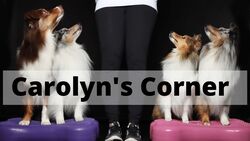
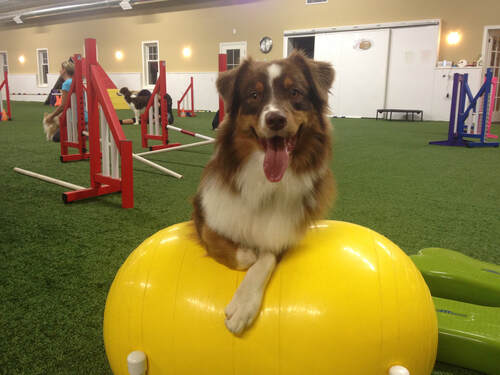
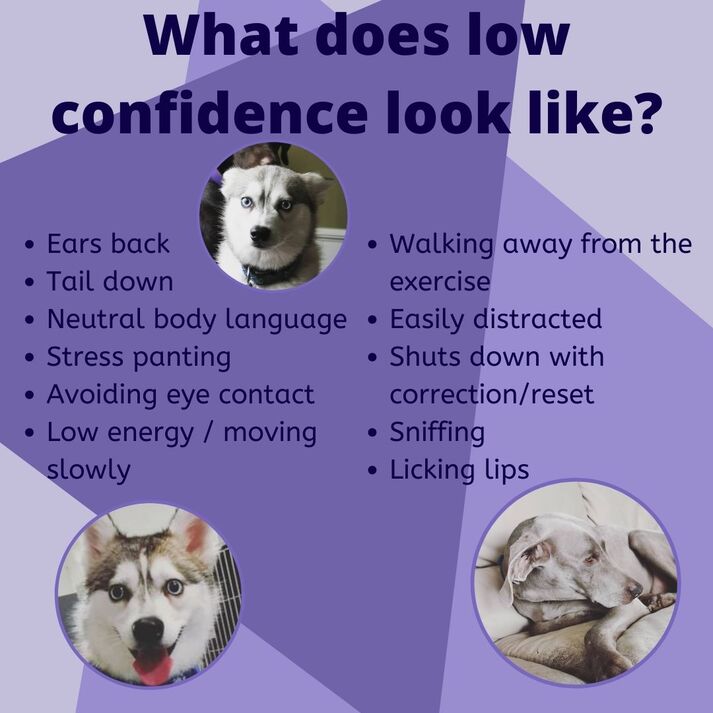
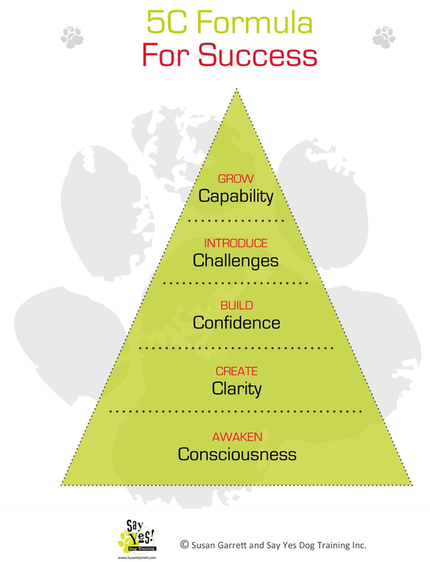
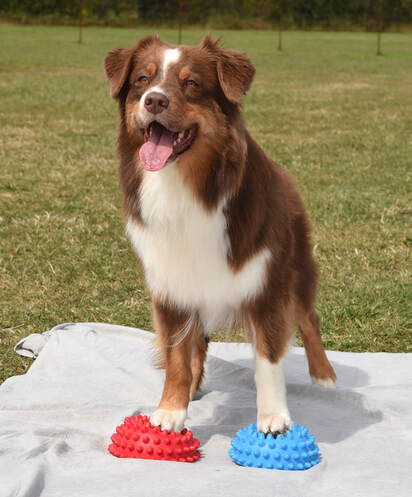
 RSS Feed
RSS Feed